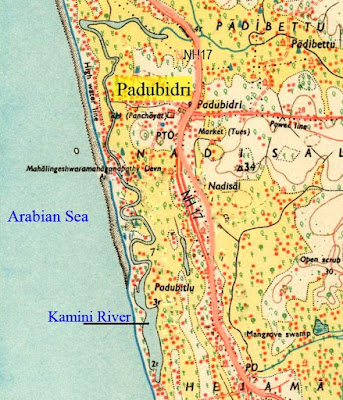Among the Tulu and Kannada words that have an indistinct source is -Banna. The word 'Banna' forms the core of village names like Bannanje, Bannadi, Bannur,Banneraghatta and probably also Banavasi.
Bannanje, Bannadi
The Karavali village name Bannanje has been made famous by celebrated scholar Bannanje Govindacharya. In Bannanje (Banna+anje) as well as in Bannadi (Banna+aDi), the word 'banna' forms the core.
The nearest known analogous words for 'banna' are- 'bana' (=forest), 'baNNa' (=colour) and 'bannana' (=calamity, problem). Banni (Prosopsis cinaria, Linn.(Mimosaceae) is a tree revered by Kings during Dasara festivities.(Note the place 'Banni Mantapa' in Mysore where traditional Dasara celebrations are conducted.)However none of these provide relevant meaning to the cited place names.
Similarly, there is a hamlet known as Bannadka near Padumarnad, Mudabidri.
Bannera-ghatta
Bannerghatta in the outskirts of Bangalore city provides better clue to the origin of the word. Bannera ghatta represents the 'ghatta' (=hilly terrain) inhabited by the people called 'Banner'(plural of Banna).
And who are these Banner or the Banna?
Ethiopian tribe
The search for the roots of Banna takes us back to African-Ethiopian connections. Banna are an Ethiopian tribe. The Banna tribes presently live in South Omo Province in the southwestern region of Ethiopia.The place names like Banna-anje and Bannera-ghatta in southern India suggest that some of these banna tribes migrated and settled in parts of southern India in the historical past.
Banavasi
Banavasi area near Sirsi in Uttara Kannada district formed important centre of socio-political significance during the history. On the basis of analogy of names it can be suggested that originally Banavasi was something like 'Bannavashe' that was transformed to stylish 'Banavasi' with passage of time. There are village names like Kervashe (near Karkala) that are similar to Bannavashe.
Banna
A few Banna tribes appear to have migrated to southern India and merged with the regional social environs during or prior to the onset of Common Era. Banna were a dominant tribes of socio-political significance in southern India. The 'Bannaya' title was referred to respected persons in Tulunadu. Banna proper names and surnames were common among early Buddhist and Jain people including rulers. We hear about Banna Perumal in Kerala history. Similarly Bannaya, Kundara-bannaya, Bannintaya, Bannanjethaya etc surnames were common among Brahmins of Tulunadu.
The 'Banni tree' could have been a prickly shrub brought by or popularized by the Banna tribes.
®
Bannanje, Bannadi
The Karavali village name Bannanje has been made famous by celebrated scholar Bannanje Govindacharya. In Bannanje (Banna+anje) as well as in Bannadi (Banna+aDi), the word 'banna' forms the core.
The nearest known analogous words for 'banna' are- 'bana' (=forest), 'baNNa' (=colour) and 'bannana' (=calamity, problem). Banni (Prosopsis cinaria, Linn.(Mimosaceae) is a tree revered by Kings during Dasara festivities.(Note the place 'Banni Mantapa' in Mysore where traditional Dasara celebrations are conducted.)However none of these provide relevant meaning to the cited place names.
Similarly, there is a hamlet known as Bannadka near Padumarnad, Mudabidri.
Bannera-ghatta
Bannerghatta in the outskirts of Bangalore city provides better clue to the origin of the word. Bannera ghatta represents the 'ghatta' (=hilly terrain) inhabited by the people called 'Banner'(plural of Banna).
And who are these Banner or the Banna?
Ethiopian tribe
The search for the roots of Banna takes us back to African-Ethiopian connections. Banna are an Ethiopian tribe. The Banna tribes presently live in South Omo Province in the southwestern region of Ethiopia.The place names like Banna-anje and Bannera-ghatta in southern India suggest that some of these banna tribes migrated and settled in parts of southern India in the historical past.
Banavasi
Banavasi area near Sirsi in Uttara Kannada district formed important centre of socio-political significance during the history. On the basis of analogy of names it can be suggested that originally Banavasi was something like 'Bannavashe' that was transformed to stylish 'Banavasi' with passage of time. There are village names like Kervashe (near Karkala) that are similar to Bannavashe.
Banna
A few Banna tribes appear to have migrated to southern India and merged with the regional social environs during or prior to the onset of Common Era. Banna were a dominant tribes of socio-political significance in southern India. The 'Bannaya' title was referred to respected persons in Tulunadu. Banna proper names and surnames were common among early Buddhist and Jain people including rulers. We hear about Banna Perumal in Kerala history. Similarly Bannaya, Kundara-bannaya, Bannintaya, Bannanjethaya etc surnames were common among Brahmins of Tulunadu.
The 'Banni tree' could have been a prickly shrub brought by or popularized by the Banna tribes.
®





